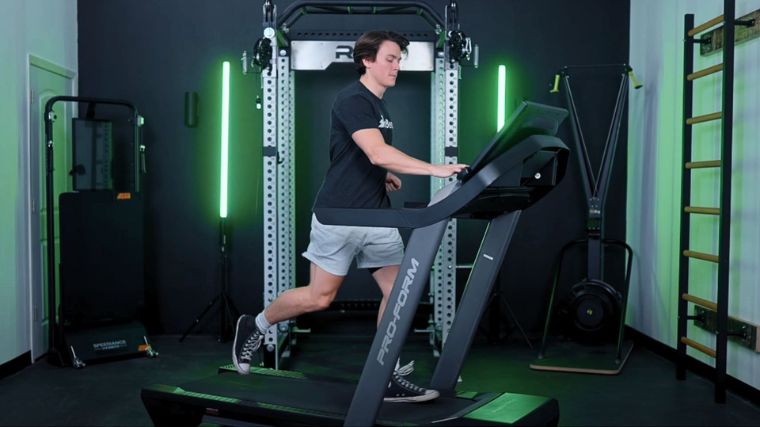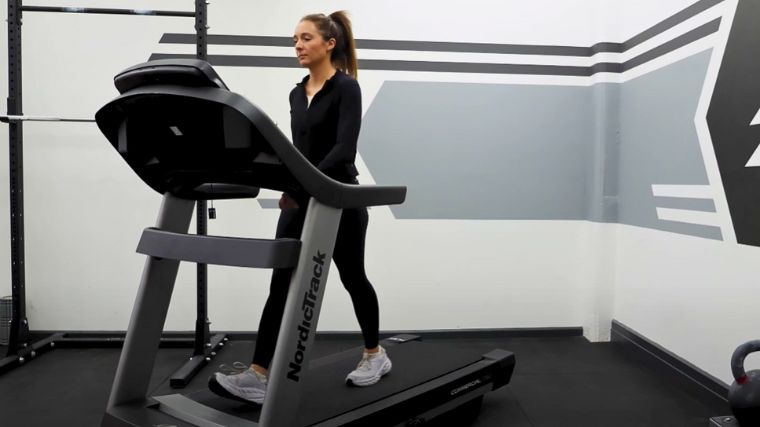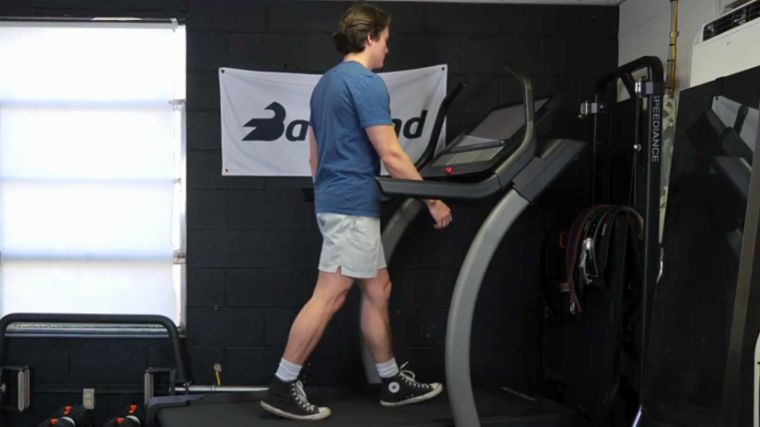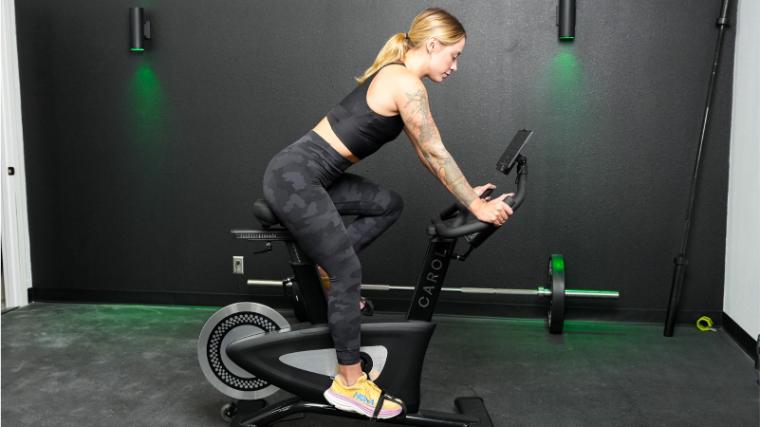Sure, you can deadlift an absurd amount of weight. But how much stress can your heart tolerate? To perform at your best, you really don’t want to neglect your cardiovascular health. After all, your ticker helps you both recover from hard workouts and live a longer life. (1)

Testing your one-rep max on the platform is simple — not easy, but simple. You pick something heavy up, and you put it down. But how do you test your cardio fitness? Here, I’ll walk you through the Bruce protocol stress test. You can do the test in a lab with a medical provider, or do your own version with a treadmill and a heart rate monitor. It’s less stressful than it sounds.
What Is the Bruce Protocol Treadmill Test?
The Bruce protocol is a treadmill stress test to help you determine how well your body can process oxygen during exercise. By walking faster and faster and at higher and higher inclines on the treadmill, you’ll gain insight into your VO2 max, or maximal oxygen uptake. From there, you’ll have an idea of how efficiently your heart can keep up with you during exercise.
This stress test is divided into seven stages, each three minutes long. At every three-minute interval, you’ll increase your pace and incline to specific levels. The idea is to gradually boost the intensity so you can see how long it will take you to get to 85 percent of your maximum heart rate (or otherwise have to call it quits).
From there, you can use some simple math to calculate some important figures about your aerobic fitness — namely, VO2 max and METS. I’ll explain more soon, but spoiler alert: both of these numbers help you determine how cardiovascularly fit you are.

[Read More: The Best Treadmills with Screens, As Chosen by Our Experts]
There are a few steps involved here — some physical and some mathematical (don’t worry, I’ll break it all down for you nice and easy). Here’s what to expect:
- You need to know one number going into your test — your maximum heart rate. I’ll explain how to find it below (it’s easy).
- Perform the Bruce protocol stress test on a treadmill with a heart rate monitor, or with a healthcare provider who can collect a lot more data. This won’t take longer than 21 minutes, but will likely be faster.
- Use the number of minutes you lasted during the test to help calculate your VO2 max.
- Use your VO2 max to check out your METs and get your measure of cardiovascular and aerobic fitness.
OK, that’s a lot of steps for such a quick treadmill workout. Don’t fret — I’ll explain piece by piece below.
What Is VO2 Max?
A huge goal of the Bruce protocol is to help you find your VO2 max. That’s the maximum amount of oxygen your body can use during highly intense exercise. Because it helps you understand how well your heart — which remember, is a muscle! — can support your high-intensity efforts, it’s generally regarded as an excellent indicator of cardiovascular health and aerobic fitness. (2)
Even as a strength athlete, you want a high VO2 max, because it sets the upper limit on your training. Without a good ability to use oxygen, you’re not going to be able to get through that high-rep set of deadlifts — no matter how strong your skeletal muscles are. The more oxygen you can process efficiently, the better supported you’ll be during your workouts.
What Are METs?
Your VO2 max is not the only thing that this stress test will help you find. You’ll also be using your results to calculate your METs. No, not the baseball team — we’re talking metabolic equivalents here.
You might see METs as a number alongside things like distance and calories on cardio machines like exercise bikes or ellipticals. You’re in luck now, because you’re about to finally understand what the heck those numbers are talking about.
Using one MET? You’re just chilling. You’re not using that much oxygen per minute — which is what METs measure — as compared to working out hard. (3)
When an activity “costs” you five METs, you’re basically working five times as hard (using five times as much oxygen) as you are when you’re just relaxing.
Ultimately, the Bruce Protocol test helps you determine your METs at the high point of exercising. From there, you can get a good idea of your aerobic fitness level.
Results of the Bruce Protocol Treadmill Test
Whether you stop the stress test because you’ve achieved 85 percent of your max, because you’ve completed all 21 minutes, or because you had to tap out early for any reason, you’ll want to gather your results.
The first step: mark the number of minutes you spent on the treadmill during the test. Once you’ve had some water and toweled down, grab a calculator (or a pen and paper if you’ve got skills).
You’ll use the following equation — and that number of minutes — to calculate your VO2 max.

[Read More: The Best Fitness Apps]
Below, T is for the total time you spent on the treadmill during the test in minutes. So if you lasted six minutes, you’ll plug a six into the equation in place of the T.
Here’s the equation* you’ll use to calculate your VO2 max for your Bruce Protocol test:
- Women: 4.38 x T – 3.9 = VO2 max
- Men: 14.8 – (1.379 x T) + (0.451 x T²) – (0.012 x T³) = VO2 max
*Note: For nonbinary athletes, you might choose to use an equation for your sex assigned at birth or for whichever binary gender you feel more aligned with or have more hormones associated with (if either). Some nonbinary athletes complete both equations and form an average. Consider consulting a trans-competent medical professional or personal trainer for a more personalized assessment.
So you’ve got your VO2 max, but you’re not quite done yet. Time to find your METs.
Divide your VO2 max number by 3.5 to find your MET value.
And finally, it gets easier — not more uphill slogs, and no more math. Just take a look at this chart to get an idea of how your aerobic fitness is doing: (4)
- Less than 5: poor
- 5-8: fair
- 9-11: good
- 12 or more: excellent
Researchers came up with these qualifiers based on survival rates of cardiac events. People who got to more than 10 METs had a generally much better prognosis of survival even with cardiovascular diseases than those who couldn’t do the Bruce protocol for more than six minutes (less than five METs).
[Read More: Expert Tested: The 10 Best Cushioned Treadmills]
The goal will be to, over time, gradually increase the number you get at the end of your calculations — or simply to last longer during the Bruce protocol.
Even small increases in aerobic fitness have been shown to help people tremendously: improving your Bruce score by even one MET can indicate a significantly smaller likelihood of cardiac events in people across age ranges. (4)
To do this, you’ll likely want to walk or jog more often, gradually increasing your tolerance to aerobic exercise until your cardio health begins to improve.
Check out some of my favorite cardio workouts and guides here on BarBend to help you get started:
- What is Cardio? How to Get Started (+ Best Types of Exercise for Beginners)
- Is Walking Good Cardio? Certified Personal Trainers Explain
- The Best 5 Treadmill Walking Workouts From a CPT (+ Insight From a Conditioning Coach)
- The Best HIIT Cardio Workout for Beginners (+ Customizations for Every Fitness Level)
- The 5 Best Running Workouts to Level Up Your Conditioning
How to Do the Bruce Protocol Stress Test
You know what to when it’s time to find your one-rep max. But a max-effort cardio test — especially with so much math! — may be understandably intimidating. Let’s take it step-by-step, literally, and you’ll be through the test in no time.
Calculate your Heart Rate Maximum
Your heart rate maximum (aka MHR or HRmax) is pretty straightforward — it’s the fastest rate at which your heart is capable of beating. Knowing this number is the first step to taking your Bruce protocol treadmill test. The goal will be to stop your test once you get to 85 percent of your HRmax.
Don’t know yours? Not a problem. Check out BarBend’s guide to how to calculate your maximum heart rate for all the info you need. If you’re in a rush, do 220 minus your age for an estimate.
Stages of the Bruce Protocol Treadmill Test
Now that you’ve got your max heart rate in mind, it’s time to step onto to treadmill. Here’s how it will do.
During each stage, you’ll walk on a treadmill for predetermined paces and inclines; along the way, you’ll be measuring your heart rate. If you’re doing this with a healthcare professional, they’ll also be monitoring your heart rhythm, blood pressure, and electrical activity.
The whole time, you’ll be increasing the pace and incline at each three-minute mark.
Here’s the entire protocol:
| Stage (three minutes each) | Pace (miles per hour, mph) | Incline (%) |
|---|---|---|
| 1 | 1.7 | 10 |
| 2 | 2.5 | 12 |
| 3 | 3.4 | 14 |
| 4 | 4.2 | 16 |
| 5 | 5.0 | 18 |
| 6 | 5.5 | 20 |
| 7 | 6.0 | 22 |
[Read More: Best Commercial Treadmills]
To perform a modified Bruce protocol, you’ll add two stages for a total of six more minutes. You’ll go slower throughout most stages and start at an incline of zero instead of 10 percent.
Here’s the outline of the modified protocol:
| Stage (three minutes each) | Pace (miles per hour, mph) | Incline (%) |
|---|---|---|
| 1 | 1.7 | 0 |
| 2 | 1.7 | 5 |
| 3 | 1.7 | 10 |
| 4 | 2.5 | 12 |
| 5 | 3.4 | 14 |
| 6 | 4.2 | 16 |
| 7 | 5.0 | 18 |
| 8 | 5.5 | 20 |
| 9 | 6.0 | 22 |
Regardless of the protocol type, stop the test immediately if you’re experiencing any chest pain, leg cramps, wheezing, arrhythmias, or abnormal blood pressure increases or decreases.
Pro tip: Even if you’re not doing this with a medical professional, it might help to have a friend close by. Just like you’d have a spotter to help keep you safe while you max out, having an attentive training partner on hand will be helpful here. At the very least, they can call out or even input the pace and incline for you at each interval.
When to Stop the Bruce Protocol Treadmill Test
You can think of the Bruce Protocol test as something like maxing out — you’re not sure what number you’ll get to before you stop, but you’ll tap out once you reach failure.
The goal is to find the mark where you get to 85 percent of your VO2 max.
Since you’re dealing with your heart here, there are certain signs and symptoms you’ll want to look out for to determine when to stop your test. Here are the symptoms to monitor yourself closely for. Be honest with yourself and stop the test when you notice any of these signs: (5)
- Drop of more than 10 mmHg in systolic blood pressure (the top number of a blood pressure reading)
- Systolic blood pressure reaching 250 mmHg
- Diastolic blood pressure (the bottom number of a blood pressure reading) higher than 115 mmHg
- Arrhythmias
- Chest pain or angina
- Shortness of breath, fatigue, leg cramps, wheezing
[Read More: The Best Treadmills for Heavy People]
Since this is a cardiovascular workout, you will of course be breathing heavily. That’s why it’ll be extra important to pay close attention to your body. Is it your usual level of effort, or are you feeling lightheaded? If you’re not monitoring your blood pressure during the test, you’ll want to pay particular heed to whether you feel lightheaded, woozy, or foggy. Stop immediately in those cases.
You can (and should) also stop the test when you’re simply ready to call it quits. The idea of the test is to get a baseline, and that’s exactly what you’ll get from listening to your body.
Alternatives to the Bruce Protocol
The Bruce protocol is a fantastic treadmill test to measure your cardiorespiratory fitness, but it certainly isn’t the only one. Here, I’ll lay out a few different options for testing your aerobic fitness in a similar fashion to the Bruce protocol — no incline treadmill required.
YMCA Step Test
The YMCA step test uses a straightforward step-up protocol to help estimate your cardiovascular endurance. While it does not provide a prediction of your VO2 max, you’ll still be able to measure your performance.
To perform the YMCA step test, set up a 12-inch box to serve as your platform. Set a step cadence of “up-up, down-down” where each foot steps onto the box before both step down. Aim for a pace of 24 steps per minute.
[Read More: Best Step Up Platforms on the Market]
Perform the YMCA step test for three consecutive minutes and measure your heart rate immediately upon completion. You’ll then compare your heart rate to others’ results to help give an idea of your aerobic fitness.
YMCA Cycle Test
The YMCA cycle test is a multi-stage incremental test similar to the Bruce protocol. It uses three-minute stages and increasing resistance with consistent pacing to gauge your fitness level.
You set an upright exercise bike and get going with a consistent cadence of 50 revolutions per minute. Slowly increase the resistance based on the recommendations of the test for your heart rate level.

[Read More: The Best Air Bikes for Your Home Gym]
When you finish the initial stage, check your heart rate and skip to the suggested level of difficulty. From there, each stage would increase in difficulty until you reach 85 percent of your heart rate max — just like you do with the Bruce protocol.
Rockport Walking Test
The Rockport walking test is an extremely accessible choice for estimating your VO2 max. All you need is a stopwatch and a one-mile track of preferably flat course to walk on.
Walk the one-mile course as quickly as possible and measure your heart rate immediately upon completion. You would then plug the heart rate into a calculation to determine your predicted VO2 max.
When to Do the Bruce Protocol Stress Test
Performing a stress test should only be done under the supervision of a cardiologist if you’re suffering from heart disease, coronary artery disease, angina, or any other pre-existing condition that may be cause for concern.
However, if you are a low-risk, apparently healthy individual who’s been cleared for intensive exercise, you can certainly use the Bruce protocol to help determine your baseline fitness level. Here are some spots where you can slot it into your program.
- Perform the Bruce protocol at the very beginning of your cardiovascular fitness routine.
- Use the results to determine target heart rate zones for your training sessions.
- Retest the Bruce protocol against your baseline once every two to three training cycles to gauge improvement and adjust training sessions accordingly.
Takeaways
The Bruce protocol treadmill stress test gauges your aerobic fitness level. At the most basic level, you’ll need a treadmill with a high incline capacity and a heart rate monitor. Bring a training buddy to spot you, just like you would for a strength training max-out session. The protocol will hopefully last longer than six minutes but will last no longer than 21 minutes.
Here are all the steps in a nutshell:
- Calculate your maximum heart rate — for a basic number, subtract your age from 220.
- Multiply this by .85. That’s 85 percent of your max heart rate — that’s the number you’ll be watching for during your test.
- Use a treadmill and heart rate monitor to conduct your Bruce protocol stress test. Watch your heart rate for when it hits 85 percent of your max heart rate. Stop the test then (immediately stop if you are wheezing, lightheaded, or experiencing chest pain). The longest it will take is 21 minutes, but it may be much quicker, too.
- You’ll use the number of minutes you last on the treadmill to calculate your VO2 max.
- Divide your VO2 max by 3.5 to get your METs. The higher your METs, the better your aerobic fitness. (Less than five is often regarded as poor, while greater than 10 is often regarded as good and excellent.)
Frequently Asked Questions
The Bruce protocol is more than just a cardiac stress test. Here are some frequently asked questions to clarify some details that surround it.
What is an exercise stress test?
An exercise stress test is a controlled bout of exercise designed to assess a certain area of fitness. The Bruce protocol is considered a cardiac stress test as it specifically challenges and measures your heart rate response to increased exercise difficulty. Exercise stress tests such as the Bruce protocol are good screening tools for cardiorespiratory fitness and risk factors alike.
What are the METs for the Bruce protocol?
METs are short for metabolic equivalents. One metabolic equivalent is the amount of oxygen you would be consuming just existing at a resting state. (3) The more METs you can attain during your Bruce protocol test, the higher your aerobic capacity and fitness are likely to be.
How does the Bruce protocol work?
The Bruce protocol challenges your cardiorespiratory system by incrementally increasing the treadmill speed and incline on regular intervals. As the test duration increases, the challenge does as well. Based on how long it takes your heart rate to reach 85 percent of your max heart rate, the Bruce protocol predicts your VO2 max. This gives a solid indication of cardio fitness and health.
How fast do you walk on a treadmill for a stress test?
A treadmill stress test challenges your heart rate by steadily increasing the treadmill speed over time. Although you are still technically walking, the pace gets quite quick. From the beginning to end of the test, you may walk between 1.7 to 6.0 miles per hour.
How long does the average person last on a treadmill stress test?
Incremental treadmill stress tests do not take long. While you may perform a full workout for 20 to 60 minutes at a time, a treadmill stress test usually lasts well under that. Depending on your fitness level, the Bruce protocol itself may last anywhere between three to 21 minutes.
References
- Harber, M. P., Kaminsky, L. A., Arena, R., Blair, S. N., Franklin, B. A., Myers, J., & Ross, R. (2017). Impact of Cardiorespiratory Fitness on All-Cause and Disease-Specific Mortality: Advances Since 2009. Progress in cardiovascular diseases, 60(1), 11–20.
- Hawkins, M. N., Raven, P. B., Snell, P. G., Stray-Gundersen, J., & Levine, B. D. (2007). Maximal oxygen uptake as a parametric measure of cardiorespiratory capacity. Medicine and science in sports and exercise, 39(1), 103–107.
- Jetté, M., Sidney, K., & Blümchen, G. (1990). Metabolic equivalents (METS) in exercise testing, exercise prescription, and evaluation of functional capacity. Clinical cardiology, 13(8), 555–565.
- Kharabsheh SM, Al-Sugair A, Al-Buraiki J, Al-Farhan J. Overview of exercise stress testing. Ann Saudi Med. 2006 Jan-Feb;26(1):1-6.
- Vilcant V, Zeltser R. Treadmill Stress Testing. [Updated 2023 Jun 20]. In: StatPearls [Internet]. Treasure Island (FL): StatPearls Publishing; 2024 Jan-.